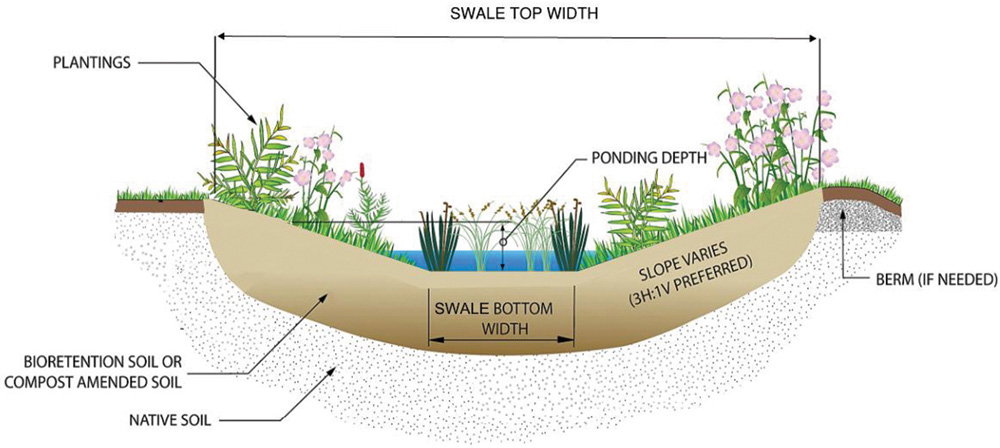
Protecting our environment, one stormwater practice at a time.
Wet Swales
Overview
Wet swales are gently sloping channels which feature wetland vegetation. Their main purpose is to treat stormwater pollution and convey runoff. Unlike vegetated swales, wet swales are typically installed below the water table and are designed to stay wet. This practice encourages the growth of wetland vegetation and simulates the water quality benefits of a natural wetland. Wet swales are commonly installed in parking lots and along roads and are designed to replace traditional curbs and gutters. Wet swales are most successful in areas with a high water table and flat terrain.
How Wet Swales Work

Wet swales remove sediment and nutrients. They slow and temporarily store runoff, allowing sediment to settle on the bottom of the channel. Small check dams or weirs can be added to further slow the runoff, which reduces the potential of erosion further downstream. Ponding depths of 18 inches or less are recommended. The wetland-like environment of a wet swale treats stormwater through microbial activity, a process where microorganisms break down pollutants. Vegetation treats stormwater through biological uptake. Plants absorb nutrients for nourishment and growth.
Cross-section illustration of a wet swale courtesy of Seattle Public Utilities.

How to Maintain Wet Swales
- Examine channel bottom for evidence of erosion, braiding, excessive ponding or dead vegetation monthly
- Remove sediment in channel as needed, especially if depth exceeds 20 percent of design depth
- Inspect upstream and downstream of check dams for evidence of undercutting or erosion monthly
- Remove any accumulated sand or sediment deposits behind check dams as needed
- Check side slopes and grass filter strips for evidence of erosion monthly
- Remove trash and blockages as needed
- Weed to maintain native vegetation (monthly weeding is recommended during the growing season)
- Replant in spring and fall to maintain plant composition consistent with design
- Prune in early spring
Suggested Maintenance Timeline
Inspect channel bottom, side slopes and grass filter strips for erosion: All year long
Inspect check dams for erosion: All year long
Remove Trash: All year long
Pruning: March
Weeding: April through November
Replanting: April and October
Remove sediment in channel and behind check dams: As needed, all year long
FairFacts
- Wetland swales can be planted with a mixture of shrubs, perennial and herbaceous plants and grasses with a high density of fibrous roots. Native species are highly encouraged. Elderberry, Bald Cypress, Broad-leaf Arrowhead, Blue flag Iris, Common Rush and sedges are all appropriate species to plant in wet swales.
- Wet swales act as a cross between a wetland and a swale.
- Areas such as the Coastal Plain are best suited for wet swales due to their high water table and flat terrain.
- Depending on their design, wet swales can remove 20 to 40 percent total phosphorus and 25 to 35 percent total nitrogen from stormwater runoff.
The information in this fact sheet is general in nature and is not intended to determine maintenance responsibility.
For more information, contact:
Department of Public Works and Environmental Services, Maintenance and Stormwater Management Division
10635 West Drive, Fairfax, VA 22030
703-877-2800, TTY 711
ContactMSMD@fairfaxcounty.gov

